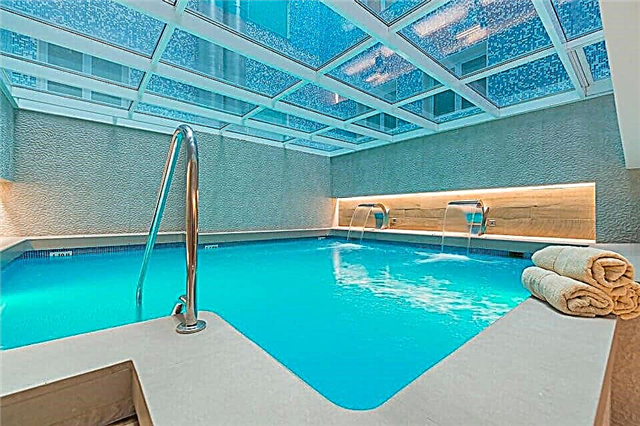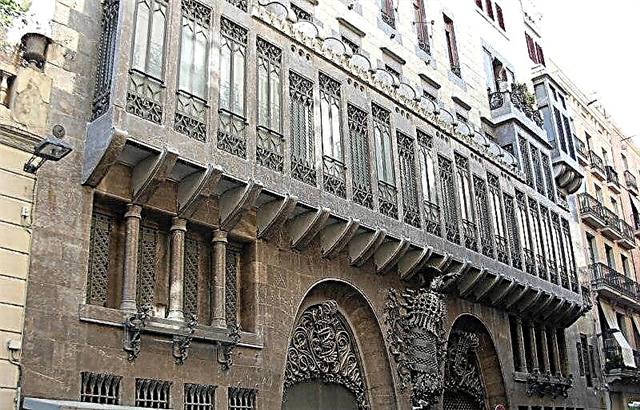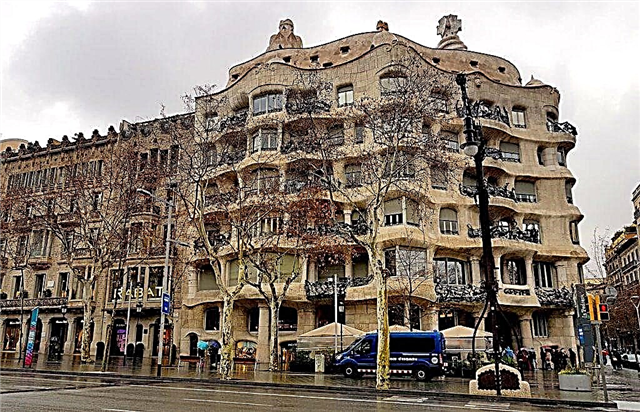In one of the picturesque and distinctive areas of Rome, on the western bank of the Tiber, a magnificent architectural monument - Villa Farnesina - is comfortably located. This expressive object of the cultural heritage of the Italian Renaissance is famous for its aristocratic interior decoration. The interiors of the mansion's halls of amazing beauty are decorated with unique frescoes and colorful paintings created by eminent masters of the 16th century brush. Villa Farnesina in Rome is an important landmark with a particularly quiet and peaceful atmosphere. It is like a precious box where architecture merges into a single amazing synthesis with works of art. Here tourists have the opportunity to enjoy unique pieces of art without fuss and rush.
Construction history

The history of the construction of an old mansion dates back to the 16th century. The famous banker Agostino Chigi, who was engaged in lending to the popes and noble citizens of the Eternal City, decided to build a country residence for himself. The implementation of the project of the villa was entrusted to the famous Italian architect of the time - Baldassar Peruzzi.
The Chigi banker patronized many artists, among whom was the outstanding Rafael Santi. The brilliant master of painting with his students took part in the painting of the walls and ceilings of the halls of the mansion. As a result, each room of the villa was filled with colorful frescoes illustrating the classic plots of ancient Roman and Greek myths.
In 1577, the palazzo was acquired by Cardinal Alessandro Farnese, who gained fame as a philanthropist and art collector. It was the Farnese family that gave the name to this remarkable architectural wonder. Today the mansion is owned by the municipality of Rome. The building is a masterpiece of the Renaissance style of architecture and a cultural monument of architecture of the capital of Italy.
Architecture and interiors

The two-storey pavilion-type mansion is shaped like a horseshoe in plan. The two wings of the building are connected by a glazed loggia decorated with high arches. The villa differs from the typical Renaissance architecture. This is evidenced by the absence of columns, marble ornaments, arched window openings and stone cladding outside.
The facade of the building is surrounded by a frieze. The main decoration of the exterior of the villa is the bas-reliefs located on the attic, as well as pilasters and horizontal belts (rods). There is a landscape park in the courtyard of the palazzo. The alley with orange and tangerine trees, which fill the air with amazing aromas during the flowering period, gives the luxurious structure a special charm.
Delight is caused by the interiors of the Farnesin Palace. Its rooms are richly painted with magnificent frescoes by famous Italian painters of the 16th century. Rafael, Piombo, Penny, Peruzzi, Romano and Sodoma worked on the design of the villa's rooms. Admirers of beauty will enjoy the contemplation of unique paintings.
Frieze room

Noteworthy is the "Frisian Room". The main element of the decoration of this hall is colorful drawings located under the ceiling of the room. A wide stucco frieze encircling the upper part of the walls is decorated with picturesque illustrations. The multi-figured tape displays scenes of the exploits of Hercules, as well as hunting scenes from the mythology of Ancient Greece. The Hall of Frisians was painted by the architect of the mansion himself - Baldassare Peruzzi.
Loggia Galatea

One of the impressive rooms of Villa Farnesina is the Loggia of Galatea. Here visitors can see the famous fresco by Raphael Santi, created at the beginning of the 16th century. This delightful, picturesque and unique panel is the Triumph of Galatea. The fresco depicts a plot from an ancient myth that tells the love story of the beautiful nymph Galatea and the shepherd Akida.
The daughter of the sea god Nereus, surrounded by newts and nereids, is rapidly moving along the waves on a shell-shaped chariot drawn by dolphins. She escapes from the pursuit of the one-eyed Polypheus, who wishes to take possession of her. Smooth and elastic light golden lines of nude figures are combined with pale blue sky and blue sea water.
Next to the fresco "Triumph of Galatea" is the giant figure of Polypheus, painted by the Venetian master Piombo. The vaults of the hall are decorated with polygonal medallions. They contain colorful panels with silhouettes of various mythical deities. The central part of the ceiling is decorated with the family coat of arms of the Chigi family. The space between the decorative elements is filled with images of angels riding on mythical animals.
Loggia of Cupid and Psyche

Especially stands out the loggia of Cupid and Psyche, which is the main entrance of the Villa Farnesina. The wide hall strikes the imagination with its delightful ceiling frescoes and amazing wall paintings, which give the interior a solemn and luxurious look. Raphael, together with talented students, created truly picturesque masterpieces.
The main theme of the frescoes was the story of heavenly and earthly love between the god Cupid and the beautiful Psyche. The central part of the ceiling of the loggia is decorated with two expressive canvases that look like tapestries. The impressive size of the paintings depicts the feast of the gods and the wedding celebration of Cupid and Psyche. The painted figures of the characters of the picturesque panels delight in their realism.
In the design of the loggia, you can see numerous images of floral ornaments. They are paintings of deciduous garlands with a huge amount of vegetables, fruits and berries. The amazing authenticity of the gifts of nature will not leave anyone indifferent.
Fireplace Hall

The Fireplace Hall is located on the second floor of the mansion. This spacious room is framed with a masterpiece of grand artistic perspective. The painter Baldassare Peruzzi created an amazing optical illusion using a special painting technique. Two rows of marble colonnades are depicted on the walls of the hall. Through them you can see the sights of Rome - the Colosseum, the Tiber, the bell towers of cathedrals, architectural ensembles and suburban landscapes.
The upper part of the hall is surrounded by a wide frieze decorated with ancient Greek mythological subjects. In the illusory niches above the window and doorways, there are panels with the figures of the gods of Olympus, influencing the earthly life of people. These are Mars and Jupiter, Neptune and Juno, Diana and Minerva, Venus and Apollo, as well as Saturn and Mercury. A fireplace is installed in the room, above which is depicted the forge of Vulcan - the patron saint of blacksmithing and fire.
Wedding hall

An equally famous room in the villa is the Wedding Hall, which once served as the matrimonial bedroom of the owners of the Villa Farnezina. Legend has it that there was a gilded luxury bed with carved ivory details. The huge bed was richly decorated with a scattering of precious stones, the value of which significantly exceeded the cost of building the villa itself.
The walls of the Wedding Hall are decorated with frescoes by the Sienese painter Sodoma. Colorful drawings artistically reflect a fragment of the life of one of the greatest military leaders in history - Alexander the Great. The stories presented tell the audience about the marriage of Alexander to Roxanne, the taming of Bucephalus and the pardon of the family of Darius.
In the main painting of the room, depicting scenes of a wedding celebration, the painter emphasized the interiors of a Roman palace. Roxanne sits under the canopy of the bed, and winged cupids dress her up. Alexander the Great holds out the crown to his beloved.
Archaeological treasures

Villa Farnesina attracts the attention of tourists, both connoisseurs of architectural and artistic masterpieces, and admirers of the history of Italy. At the end of the 19th century, during the improvement of the embankment under the garden plot of the mansion, the remains of a villa from ancient Rome were discovered. The found archaeological artifacts are decorated with antique frescoes of historical value.
Tours

Tourists can visit Villa Farnesina together with a professional guide with extensive encyclopedic knowledge of art history. The excursion program involves visiting the halls of the mansion, where the triumph of colorful painting reigns. Guests of the villa will get acquainted with the works of prominent artists of the Renaissance. The walls and ceilings of the halls are decorated with works of art reflecting the glorification of beauty and life.
The guide will fascinatingly tell the endless number of romantic legends associated with the centuries-old history of the mansion. Tour participants will have the opportunity to explore the frescoes of Rafael Santi himself without the fuss of crowds and queues inherent in famous museum complexes. The contemplation of numerous characters from mythological plots, the starry sky, colorful ornamental paintings, illusion artwork will make an indelible impression on the visitors of the villa.
Opening hours and ticket prices

Villa Farnesina welcomes its guests from Monday to Saturday. Opening hours: 9: 00-14: 00. Additionally, the doors of the mansion are open every second Sunday of the current month from 9:00 to 17:00. The ticket costs 6 euros. For young excursionists from 14 to 18 years old and people over 65 years old, a visit to the museum will cost 5 euros.
Where is it located and how to get there

To find Villa Farnesina, tourists need to go to the opposite bank of the Tiber from the ancient Roman sights. The Renaissance country mansion is located in the Trastevere area, in the narrow winding streets of which, with garlands of plants, a measured, calm atmosphere reigns. You can get to the villa by buses 23, 125, 271, 280 or by tram number 8.











